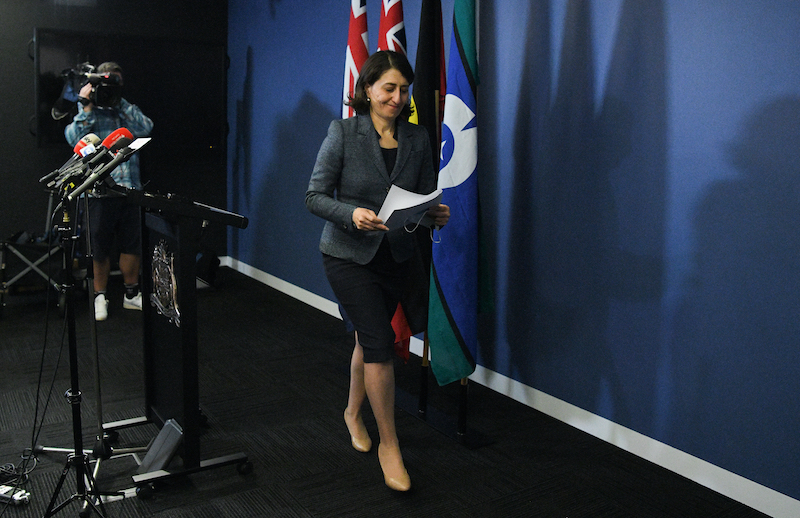The decision by Gladys Berejiklian to not contest the seat of Warringah deprives us of what would have been one of the marquee battles of the 2022 federal election. But there are many other independent v Liberal contests looming as the local movements target a swathe of Coalition MPs (and a few Labor). Berejiklian’s decision all but guarantees the return of independent Zali Steggall. But the long-term picture is not so clear. Minority government, especially if led by Labor, spells opportunity but also danger for Steggall and other independents in traditionally Liberal seats, writes Mark Sawyer.
The trial balloon that was to carry former NSW premier Gladys Berejiklian to Canberra is floating back to earth. If you live in Warringah, you might see its tatty ribbons hanging sadly off a tree or two, the dreams of a Liberal comeback in a vital seat crashing with it.
It must have seemed like a neat piece of genius thinking. Bring Warringah back into the Coalition fold by running a local gal (born Manly Hospital) against the seemingly invincible giant-killing independent Zali Steggall.
The idea never had legs, as the most hard-headed Liberal operatives must have realised when they poked around at the struts of Steggall’s formidable power base. To state the obvious, a campaign run by a well-liked but ICAC-tainted Berejiklian against one of Parliament’s prime movers for clean government, was doomed from the outset. Even if successful, it would not even have saved a crumbling government.
Berejiklian is headed for the private sector, but you can never say never in politics. And there are less easily noticed reasons why Berejiklian could play a long game and be a serious contender for the seat in 2025. It might be one of the lesser known maxims of Australian politics: that while it is enormously difficult for an independent to win a seat in Federal Parliament, they are almost always good for two terms. More on that later.
A campaign for the annals
Steggall’s successful campaign against Tony Abbott in 2019 was a masterpiece of organisation. For months, networks of anti-Abbott activists had been building a plan to get him out of Parliament.
Abbott had dismayed much of his electorate and disgusted many other Australians when he led the government that repealed Labor’s carbon price in 2014. In 2015 he was deposed as prime minister by Malcolm Turnbull. Marooned on the Coalition backbench, he looked more and more like a man out of time. He stoutly defended ”traditional” marriage even when 75% of Warringah voted yes to same-sex marriage. Then a Liberal preselection meeting attracted 30% support for an empty chair.
Social media was alight with the ”Vote Tony Out” campaign. Posters were printed, videos uploaded, T-shirts and coffee mugs made. Inspiration was gained from the successful grassroots campaign against Liberal Sophie Mirabella in 2013. Her Victorian rural seat of Indi fell to moderate independent Cathy McGowan. It was clear Abbott could lose to the right kind of candidate: conservative on economics, progressive on climate. Enter the perfect candidate, Zali Steggall, Olympian, barrister, pillar of the private-school network.
As 2019 began, with the election due in months, the runway was quickly cleared for Steggall. Another independent aspirant, Susan Moylan-Coombs, who would have been the electorate’s first credible Indigenous MP, was sidelined as the anti-Abbott forces lined up behind Steggall. Another prospective independent candidate, Alice Thompson, quietly shifted her campaign north to Mackellar.
What followed was a local campaign that will live in the annals. Steggall offered substance – and style. Warringah was carpet-bombed with Zali adoration. Her turquoise corflutes and posters were everywhere. Zali was everywhere. Her campaign material’s soothing colour scheme made a perfect contrast to fireman Abbott’s red (budgie-smuggler) hotheadedness. People held Zali campaign events in their own homes. I asked one why he wanted Abbott out. ”He’s a misogynist!” he replied.
Crucially, Warringah 2019 was a battle between moderate liberal and conservative Liberal. Small-L and big-L. The voters of Warringah were invited into the equivalent of a Liberal preselection challenge. Steggall made it clear that she wouldn’t have a bar of Labor’s plans to restrict negative gearing and dip into the money pot of franking credits that seemingly was vital to the survival of every second pensioner.
Nonetheless Labor supporters swung behind Steggall, though the odd Labor partisan must have considered voting Abbott as a spoiler tactic. A re-elected Abbott throwing his weight around the depleted benches of the defeated Coalition would wreak enjoyable havoc on conservative ranks. Conversely a neutral such as Steggall might even be an unwelcome burr in Labor’s saddle over climate change and a corruption commission. In the end such notions were moot, because the unexpected happened.
A ”safe” Liberal seat fell while Scott Morrison survived. The Coalition won a third term, with the bonus of no cranky ex-PMs hanging around the backbench like ”miserable ghosts” (copyright M. Turnbull). This macro reality tempered the celebrations at Steggall’s victory party, according to one witness of my acquaintance.
Life on a crowded crossbench
Back to 2022. Despite the Morrison government’s glaring faults, it is difficult to imagine Labor storming to office. It is likely, however, to win the most seats and gain the support of a swollen crossbench. Let’s assume some or even most of the following seats are in the ”other” camp: Warringah, Wentworth, North Sydney, Bennelong, Hughes, Indi, Kooyong, Goldstein, Mayo, Clark, two or three in Queensland and of course the Greens bastion of Melbourne.
The fun really begins as Labor grapples with the tensions of running a minority government (and suppressing its deep-seated historical animus towards independents). While it would be guaranteed confidence votes and Supply, an Albanese government would receive no assurances on its legislative program.
More likely, it would have to focus on a breakneck assault on coal and gas power under near command-economy procedures. A tall order in a federation. Queensland and WA would demand massive compensation payments for closing their dirty industries. The Hunter region in NSW and LaTrobe Valley in Victoria would need to be paid off too. Their revolts could only be quelled by huge transfers of federal money. The economics of clean energy are trending the right way, but the returns would not be immediate. Meanwhile the pressures on the budget would make Covid look like a picnic. The temptation for Albanese to rush to Yarralumla and seek a fresh election would be overwhelming.
A fresh election. Time for the delayed Gladys-Zali showdown to finally occur, though the national stakes would be much higher than any local battle.
The strengths and weaknesses of the independent movement are likely to have become clear by 2025. There is a hint of this in the fortunes of independents Helen Haines (MacGowan’s successor in Indi) and, especially, Steggall. What was a drama-filled campaign has been a fairly uneventful parliamentary term for the member for Warringah. Yes, there has been a positive agenda focused on environmental and anti-corruption reform.
Outside the News/Sky camp, the mainstream media has not been particularly negative – anything but (I cringed at the way Tony Jones fawned over Zali when she first appeared on QandA, but I was in the minority). There have been minor local grumblings about the independent MP’s visibility and effectiveness, but nothing resembling a Vote Zali Out movement.
Steggall and Haines have given the Parliament and their electorates much in the way of positive policy advocacy. But clean politics doesn’t always shell peas in Australia. One thing you don’t get when you vote for a community independent is scandal. But you don’t get a lot of grit either, the sort of messy deal-making and stirring that is the basis for real change: the pounding into the political consciousness of people for whom politics is just a ”bubble”, a stupid game, something irrelevant to their daily lives.
There’s the rub for independents operating in the majoritarian system that dictates success in our Federal Parliament. Eventually they have to pick a side. The difficulty is acute when the independent represents a conservative-inclined seat but supports Labor. In the most recent federal example, Oakeshott and Windsor backed Gillard (which was their perfect right) but made themselves (and, alas, Gillard) unelectable. (Minority rule works better in the states; in NSW the independents wrought progressive concessions from Nick Greiner.)
Progressive independents have rarely made themselves a permanent feature of Australian electorates. Idealism, and disavowal of the messy business of negotiation, leads to disenchantment or defeat. Phil Cleary, independent, won Wills from Labor in 1992 upon the retirement of Bob Hawke. He survived in 1993 but lost in 1996. Michael Organ won Cunningham (as the first Greens MP in the lower house of Federal Parliament) in 2002. He was defeated by Labor at the 2004 election.
The district that encompasses Warringah has a healthy record of supporting independents. The state seat of Manly was won four times in a row by independents Peter Macdonald (1991 and 1995); and David Barr (1999 and 2003). But after 16 years the independent brand was no longer fresh, and in 2007 Liberal future premier Mike Baird defeated Barr.
Two terms is a good yardstick. Even a community hero such as Ted Mack in North Sydney (1990-96) could not shift the dial sufficiently to make the seat an independent stronghold, although his old seat may return to the independent camp in 2022.
If the Coalition is returned, especially as a minority government, Steggall is assured another good term. With Labor in charge, the turquoise starts to run. Things should get interesting in Warringah in 2025. Berejiklian just might be tempted.
Mark Sawyer is a journalist with extensive experience in print and digital media in Sydney, Melbourne and rural Australia.

